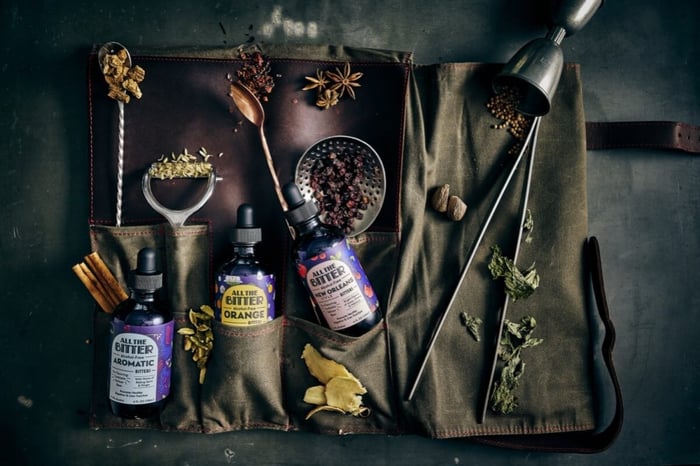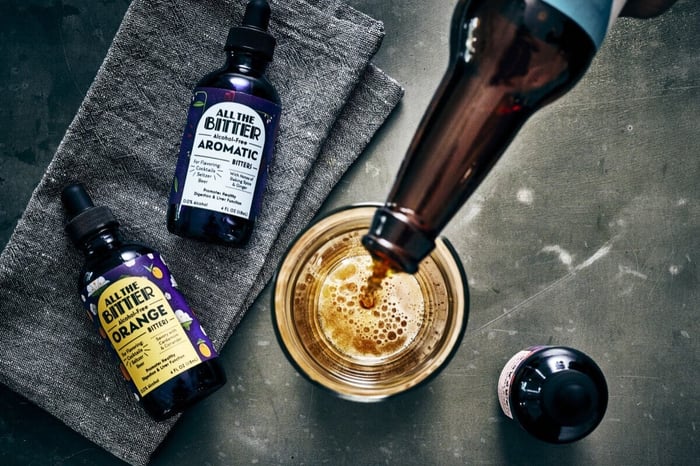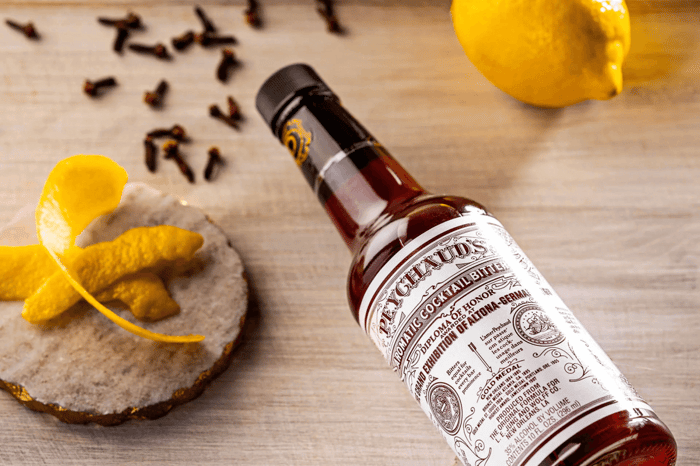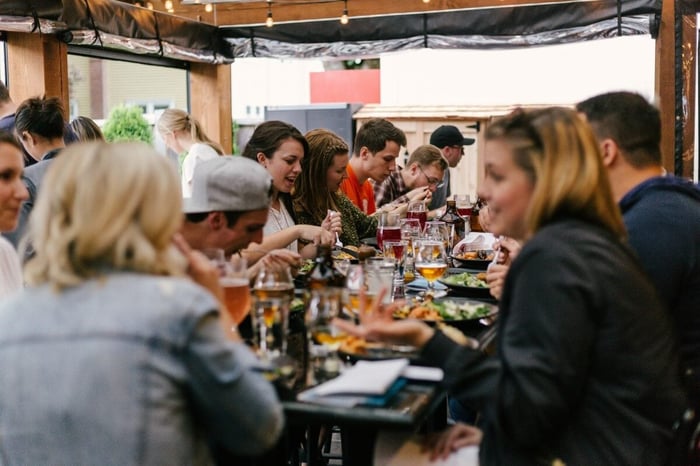The best way to think about cocktail bitters might be to call them the spice rack of the bar. Typically used in "dashes", or the equivalent of a pinch of seasoning, bitters have the ability to highlight or enhance flavor in the same way that salt or pepper might. Bitters help to balance and add another dimension to cocktails that are often dominated by sweet or sour flavors. They can even tie different elements of a cocktail together, and add complexity to drinks that might be lacking. For something that comes in such a small bottle, bitters pack a big punch! But what the heck are they? What are bitters?
Table of Contents
What Are Bitters?
Bitters are crafted by infusing a neutral alcohol base (or vegetable glycerin) with a carefully selected blend of aromatic spices, herbs, fruits, roots, and other botanical ingredients. These flavorful components lend bitters their distinct taste profiles and contribute to their versatile applications in cocktails. While recipes vary, common ingredients found in bitters include cinchona bark, which imparts a bitter and earthy note, gentian root known for its intense bitterness, warm spices like cinnamon and clove, and the zesty essence of orange peel. These ingredients are meticulously combined and macerated to extract their flavors, resulting in a complex, intense extract. Bitters typically have an alcohol content ranging from 35 to 45% ABV (alcohol by volume), but alcohol-free bitters are also available.
What are bitters made of?
Cocktail bitters are made with three primary components:
- At least one bittering agent like gentian root
- Herbs, spices, citrus, or other botanicals for flavor
- A solvent: typically high-proof alcohol, or glycerin for non-alcoholic bitters
Bitters should contain at least one "bittering agent", the most common of which is gentian root. Grown in the mountains of central and southern Europe, gentian is the workhorse for most cocktail bitters (and bitter liqueurs) because of its impressively clean and bitter flavor. Some other standard bitter ingredients are cinchona bark, quassia bark, dandelion root, burdock root, wormwood, and angelica root, but there are countless possibilities. One of our favorite, less common bittering agents is yellow dock root, which we include in small doses in each of our three classic bitters for its uniquely earthy and pungent flavor (not to mention that it might be useful in liver detoxification).
Beyond the bitter component, cocktail bitters are flavored with a wide range of ingredients. The ubiquitous Angostura and other Aromatic bitters, for instance, are typically flavored with baking spices like cinnamon, clove, nutmeg, allspice, and ginger. Citrus bitters like Regans' Orange Bitters are made with citrus peel but might also contain cardamom and coriander, for example, or even hops. Floral bitters often contain lavender, chamomile, rose petals, or hibiscus, and herbal bitters frequently use sage or eucalyptus. Dried fruits are common, especially cherries, and richer ingredients like walnuts, chocolate, and coffee are frequently employed. There are no restrictions or regulations when it comes to cocktail bitters, opening the door for unique combinations like The Japanese Bitters' Umami Bitters or The Bitter End's Curry Bitters.
Lastly, you need a solvent. High-proof alcohol has been the standard choice for its ability to extract flavor and beneficial compounds, and for its long shelf life. Another option is vegetable glycerin, which works in a similar fashion, and is especially useful for folks who aren't able or choose not to consume alcohol. This is how we make All The Bitter, in combination with water and a touch of apple cider vinegar which helps with extraction.
How bitters are made
Besides sourcing all of the esoteric ingredients—and for that we recommend Mountain Rose Herbs—making bitters is actually a pretty easy process. If you're interested in trying it out at home, there are plenty of easy-to-follow recipes on the web. The basic process to make alcoholic bitters goes like this:
- Toss your ingredients in a glass container with a lid, like a mason jar. Add your high-proof spirit, seal the container, and shake it daily for 2-3 weeks.
- Strain the liquid through cheesecloth into another container and seal it. Place the leftover botanicals in a small saucepot with water and simmer lightly for 5-10 minutes. Transfer this water, and the botanicals, into a clean jar, seal it, and let it infuse for a few days in the refrigerator.
- Using a cheesecloth, again strain the water from the solid ingredients. Combine the infused water and the spirit—this brings the ABV of the bitters down to 30-45%—and optionally add sweetener like simple syrup or honey to balance the intensely bitters flavors.
Want to make non-alcoholic bitters? The process is even easier. It starts the same way, by placing your botanicals into a clean container. Add a mixture of vegetable glycerin and water, ideally in a ratio of 75% glycerin to 25% water for shelf stability, filling the container nearly to the top (making sure there's enough room for the botanicals to float around). Seal the container and shake it daily for 6-8 weeks.
Are bitters bitter?
Funny enough, the answer is "not necessarily". Tasting bitters straight, yes, you're going to get a big old bitter slap in the face. But you're adding such a small amount to your drink, generally between 1ml - 3ml, that it doesn't necessarily make your drink taste bitter. Rather, the bitter element helps to round out the flavor profile and balances other elements like sweet and sour. Now, if you're making something like a Trinidad Sour that contains 1.5 ounces of aromatic bitters, well that's a different story! But by and large, adding bitters to your drink won't make it taste bitter any more than adding a pinch of salt to a dish will make it taste salty.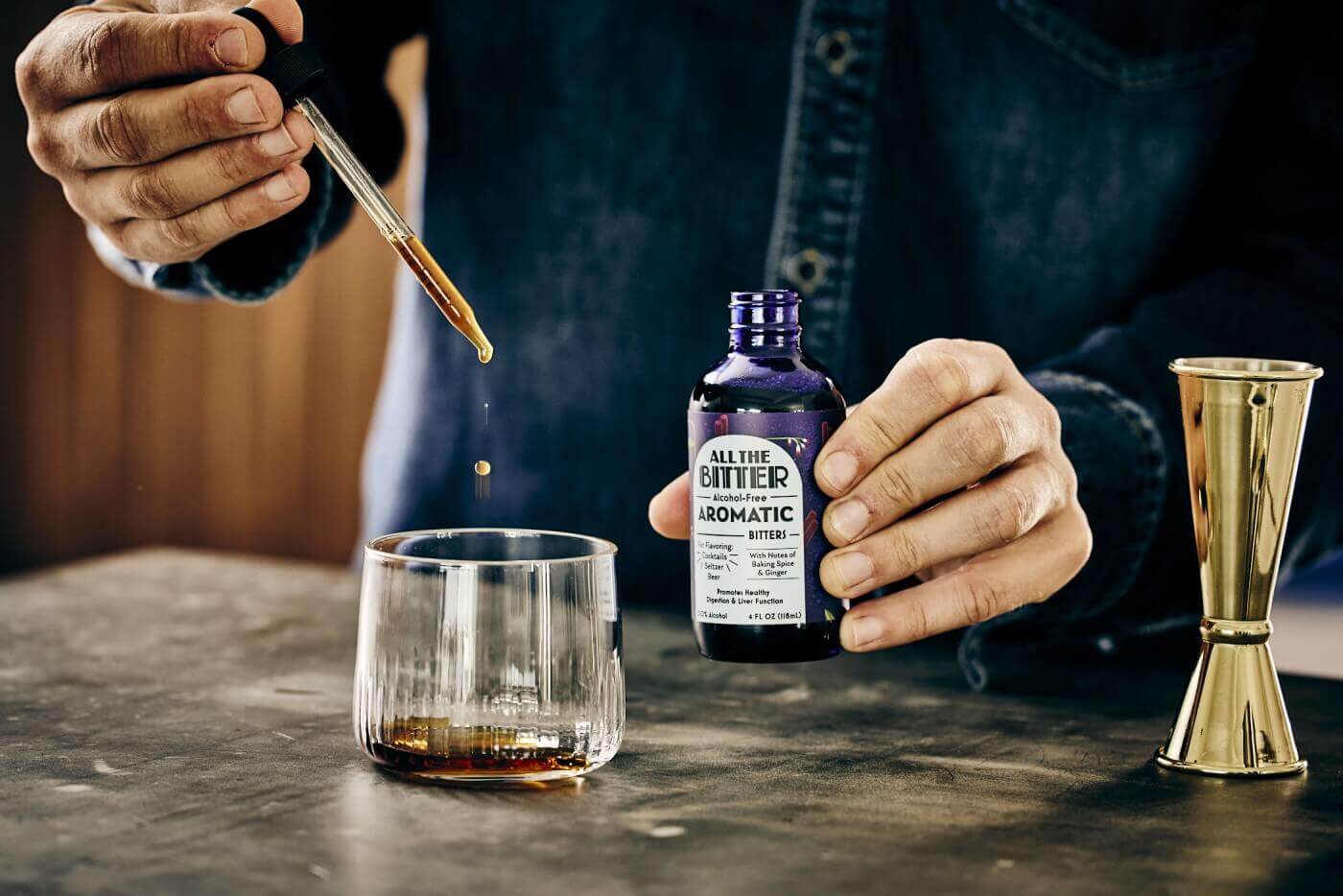
How Are Bitters Used?
While bitters might seem like the exclusive purview of trained bartenders, they're actually pretty easy to use, especially when you think of them as the spice rack of the bar. A few dashes add intrigue and depth to a drink and do an excellent job of balancing both sweet and sour flavors, which cocktails tend to have in spades.
Consider the five basic tastes: sweet, sour, salty, bitter, and umami. A drink, or a dish, might feel incomplete if it only contains one or two of those taste sensations. Now, we don't need to pack all 5 tastes into everything we eat and drink, but if you can incorporate a wider range of those flavors into your cocktail, you're going to have a more satisfying experience. Let's look at a simple whiskey sour as an example. In its most basic form, the drink contains only three ingredients: whiskey, lemon, and sugar. Adding a few dashes of Aromatic bitters isn't going to change the flavor profile dramatically—it'll still be the same whiskey sour—but it'll be more complete. Include a few drops of saline solution and now we're really firing on all cylinders!
Simple highballs are another great opportunity to use bitters. Orange bitters in a vodka soda, for example, are an easy way to bring complexity to an otherwise basic cocktail. Rum and coke? Peychaud's or another New Orleans-style bitter is a quick way to add some high-toned spice, fruit flavors, and balancing bitterness. Whiskey and ginger ale can benefit from Aromatic bitters, where the warm spice notes complement the whiskey and the bitters' ginger notes serve to enhance the mixer.
What cocktails use bitters?
About a million different cocktails call for bitters, but easily the three most famous are:
- Old Fashioned - the granddaddy of classic cocktails, an Old Fashioned includes Angostura or a similar aromatic bitter, in addition to a sugar cube, whiskey, and an expressed orange peel.
- Manhattan - made with whiskey and sweet vermouth, bitters help tie the two main ingredients together. Without them, a Manhattan would come across as slightly too sweet, but with bitters, everything melds perfectly together.
- Sazerac - this New Orleans-born cocktail, a combination of whiskey (or cognac) and sugar with an absinthe rinse, calls for Peychaud's bitters.
You could fill a book with cocktails that call for bitters—and several already have been—so we wont list them all here, but a few favorites are the Kentucky Buck, Old Cuban, and Champagne Cocktail.
Bitters and soda
The easiest way to use cocktail bitters is by mixing them with sparkling water. Bitters and soda, or "bits and bubs" as it's affectionately called, is a refreshing alternative to a cocktail that can be ordered or made pretty much anywhere. It'll work with any variety of bitters, although Angostura (or another Aromatic bitter) is most common. Simply add a few dashes of bitters to a glass of unflavored sparkling water, maybe a squeeze of lemon or lime, and voila! A quick and tasty non-alcoholic cocktail that's good for your gut, too.
Uncommon uses for bitters
Bitters shouldn't be limited to cocktails and sparkling water! Some unexpected uses for cocktail bitters include adding them to beer, coffee, tea, wine, juice, lemonade, kombucha, etc. Remember, they're basically liquid seasoning! Adding a few dashes isn't going to make your drink taste bitter, but it is going to round it out and give it a more complete flavor profile. We're not going to get into the culinary uses of bitters here, but Taste of Home has a great article that covers how you can use bitters in marinades, sauces, vinaigrettes, and baking. Our favorite uncommon use for bitters? Try a few dashes on vanilla ice cream. You're welcome.
How do you measure bitters?
Bitters are generally written in recipes as "dashes". But how much liquid is a dash? How does one go about dashing? And how much should you use when a bottle of bitters has a dropper top?
To "dash" a bottle of bitters, hold it above the drink or mixing glass, and in one fluid motion, flip it upside down and give it a strong thrust downward. That's a single dash.
Like a "pinch" of salt, there's no good answer for exactly how much a dash is, and depending on who you ask it's somewhere between 0.6 mL and 1 mL of liquid. The variance is physics. A full bottle of bitters will dispense much more slowly, maybe even as little as 0.3 mL per dash, because there's less headspace for the liquid to create velocity. As a bottle empties, more and more comes out per dash. The shape and size of the bottle, the angle you're holding it at, the size of the hole at the top, all of these things affect the amount of a dash.
If you're using a bottle with a dropper (sometimes called a pipette or sleeve), one squeeze of the bulb should suck up about 1 mL of bitters (depending on the size of the bottle and dropper). We think that's pretty damn close to a standard dash, and recommend using 1 full dropper of our bitters per "dash" called for in a recipe. Is that slightly more than your average dash? Maybe, but it's way easier than obsessing over the exact amount.
At the end of the day, bitters really are just like seasoning: measure with your heart.
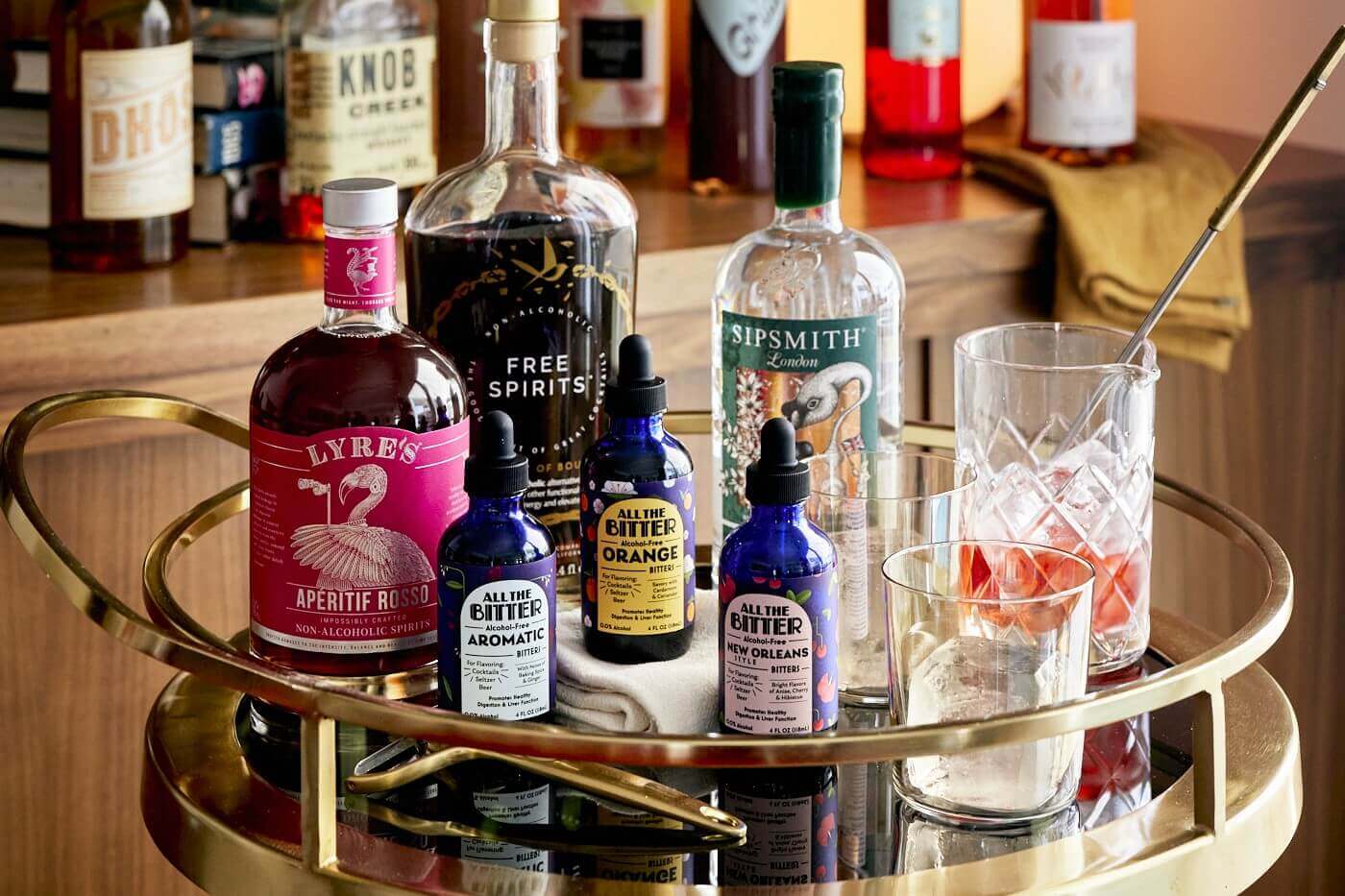
Using Bitters in Non-Alcoholic Drinks
Can bitters be used in non-alcoholic drinks? It really depends on the person you're making the drink for (maybe yourself!) and how comfortable they are with a very, very small amount of alcohol—or how literal you want to get with the term "non-alcoholic", which is defined in the US as a drink containing under 0.5% alcohol by volume. If you're writing a cocktail menu for a bar or restaurant, this should be taken very seriously.
If the drinker is okay with alcoholic bitters, they can be an incredibly powerful tool in the non-alc toolkit! Bitters add a ton of flavor to simple mixers like soda, tonic, and ginger beer, making them feel like a cocktail without really doing any work. If you're dining out and the only NA beer option on the menu is O'Douls, try asking for a pint glass with a few dashes of Angostura. It's a totally new experience. Non-alcoholic red wines not quite living up to what you hoped they would be? Add bitters.
Fortunately, for those who are looking to avoid booze completely, our bitters are made entirely without alcohol. Just organic botanicals, water, glycerin, and a touch of ACV.
Are bitters alcoholic?
Bitters are alcoholic, generally containing between 35-45% alcohol by volume. However, because bitters are typically used in such small amounts, once they're diluted into an otherwise non-alcoholic drink like a glass of club soda, they're often considered to be non-alcoholic (like vanilla extract in baking). This can be a slippery slope for folks in recovery, though. A few dashes of bitters in a non-alc cocktail certainly won't get you drunk, but one dash too many can easily put your drink over the 0.5% ABV threshold that defines "non-alcoholic" beverages, and more importantly, above the comfort level for many people who identify as sober or alcohol-free. There's a great post at Alcademics that breaks down the exact ABV of drinks made with bitters.
Are there non-alcoholic bitters?
Absolutely! Non-alcoholic bitters offer a delightful alternative for those seeking the flavors and complexity of traditional bitters without the alcohol content. One popular option is glycerin-based bitters. All The Bitter, for instance, utilizes a base of vegetable glycerin, water, a touch of apple cider vinegar, and a complex blend of botanicals to create a rich and flavorful experience. Using ingredients like gentian root, warm spices, fruit, citrus peels, and flowers, these bitters deliver enhanced flavors to cocktails, providing a similar effect as traditional bitters but without compromising on taste or alcohol content. With zero alcohol, non-alcoholic bitters offer a great solution for those looking to enjoy flavorful and well-balanced drinks without the presence of alcohol.
Can bitters get you drunk?
Bitters can absolutely get you drunk. A few dashes won't even get you buzzed, but as many an enterprising alcoholic can tell you, a standard bottle of bitters is the same as nearly 3 shots of whiskey. That dasher cap comes off pretty easily! Just because you're "not supposed to" drink bitters straight doesn't mean you can't. It might not taste great, but it'll get the job done. As such, bitters are often a hard pass for folks in recovery from alcohol abuse, making a fully alcohol-free option the much better choice.
Are Fee Brothers bitters non-alcoholic?
Despite often being misinterpreted as such, Fee Brothers bitters are not non-alcoholic. While they're made with a glycerin base, alcoholic extracts are used for flavoring, and their ABV ranges anywhere from 1.5% to 45% (however, most varieties fall under 10%). We love Fee Brothers' range of vibrant flavors like grapefruit, rhubarb, black walnut, and mint, but if you're looking to avoid alcohol completely, these probably aren't an appropriate alternative. There's a great list of Fee Bros. alcohol percentages in this post on Reddit, which was compiled from their UK labels.

The History of Bitters
Historically, bitters were taken as a medicinal tonic. Starting in the 1700s, bitters were sold as patent medicine that was touted to cure everything from digestive issues to kidney failure, jaundice, erectile dysfunction, back problems, malaria... you name it. While bitters did (and still do) have some functional benefit, especially as it relates to gut health, some of those claims were a bit far-fetched.
Medicinal bitters don't taste great, and eventually folks started adding them to alcoholic spirits to mask the taste. It was basically a spoonful of sugar to help the medicine go down, except instead of sugar, it was hard liquor. "Sweetie, it's 7 am," says the concerned wife. "Lighten up, Susan, I'm just taking my medicine." A pretty convenient way to get drunk, indeed! And thus the cocktail got its beginnings. In 1806—after two rather ambiguous mentions of the word—the cocktail was defined in a New York newspaper, The Balance and Columbian Repository, as "a stimulating liquor, composed of spirits of any kind, sugar, water, and bitters."
It's unclear exactly when it happened, but throughout the 1800s bitters transitioned from being taken primarily for medicinal purposes to seeing more action in the mixing glass. By the end of the century, bitters had firmly planted themselves as an essential cocktail ingredient.
The holy trinity of bitters
Three types of bitters can be found behind just about any bar: Angostura, Peychaud's, and an orange bitter (there are several prominent brands). These are the so-called "holy trinity" of bitters, and most cocktail recipes can be made with one of these.
Dr. Johann Siegert began making bitters in the Venezuelan town of Angostura in 1824 while he was stationed there as the Surgeon General of the armies of Simón Bolívar. Originally formulated as a digestive tonic for soldiers, by the 1850s the bitters called 'Angostura' were being exported around the world. By the time the Golden Age of Cocktails started in the 1860s—when drinks like the Manhattan were invented and the Old Fashioned become more popular—Angostura was poised to become the go-to brand of bitters for bartenders everywhere.
Right around the same time that Dr. Siegert began selling Angostura, an apothecary in New Orleans named Antoine Peychaud was creating his 'American Aromatic Bitter Cordial', Peychaud's bitters. Very different in style from Angostura, Peychaud's is brighter in flavor and relatively softer. Its hallmark is a predominant anise note, bright red color, and a light fruitiness from cherries. It's the defining ingredient in a Sazerac cocktail, and has endured along with Angostura as one of the required bitters for any well-stocked bar.
While orange bitters were popular in the late 1800s and early 1900s—being called for in many cocktails including the traditional-but-now-defunct martini recipe—they declined in popularity around the 1930s, and by the middle of the century they were nearly impossible to find. When the cocktail renaissance began in the 1990s, bartenders wanting to recreate classics were frustrated with a lack of commercially available orange bitters. Gary Regan, one of the most renowned mixologists of the time, began making and sharing his own with other bartenders, and in 2005 started selling them.
Regans' Orange bitters ushered in a new era and interest in cocktail bitters, and since their release countless new brands have hit the market. We're honored to join this long tradition with All The Bitter, a lineup of cocktail bitters inspired by the "holy trinity", made with organic and wild foraged plants, and without any alcohol.
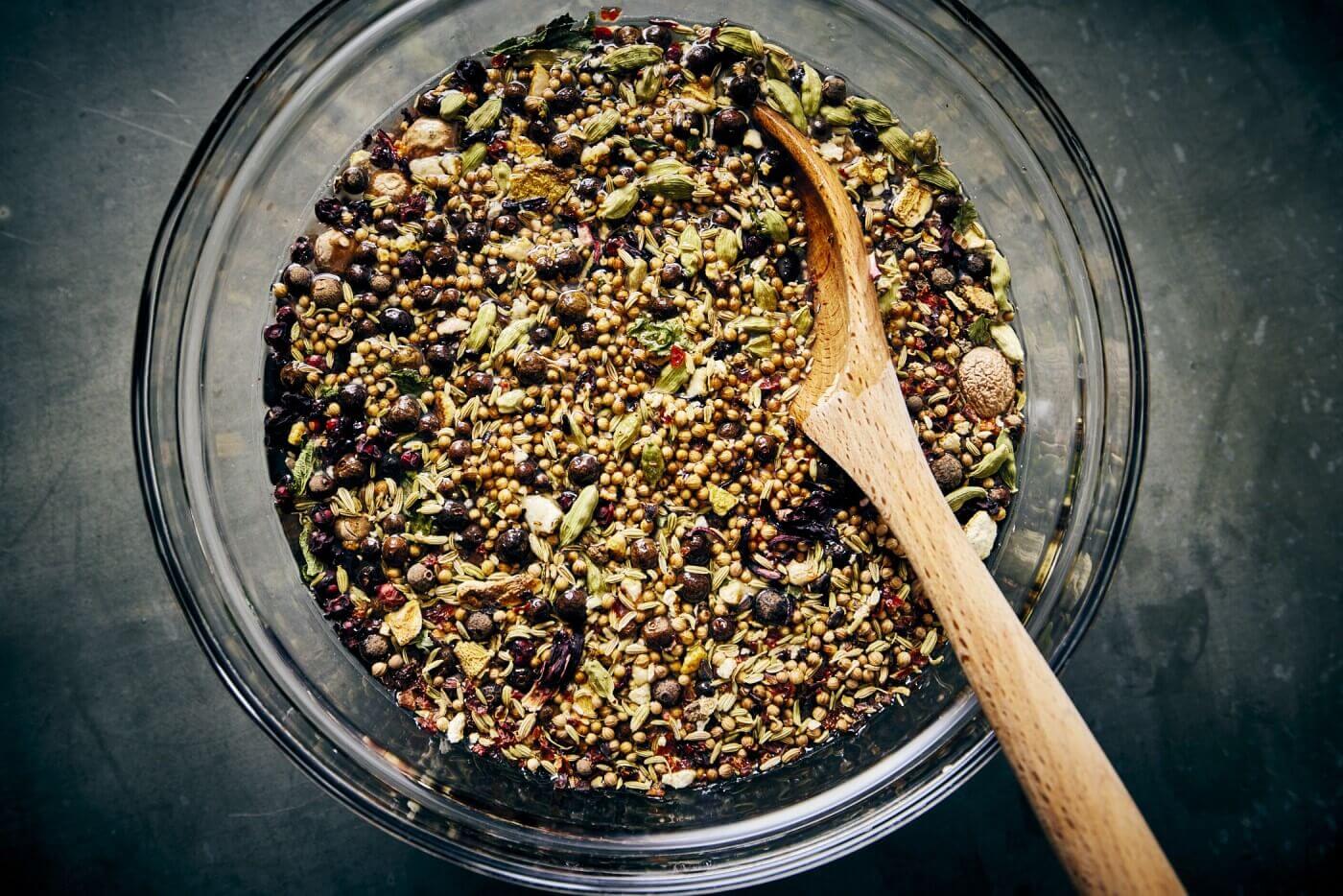
Are Bitters Good For You?
When we taste bitter flavors our bodies react by jumpstarting the flow of digestive juices in the stomach and by producing more saliva, further helping to break down food. This digestive boost in turn leads to absorbing nutrients better, detoxifying the liver, and thanks to the gut-brain connection, can actually reduce stress. It's also possible that consuming bitter foods might help control weight gain and reduce sugar cravings by activating certain receptors in our mouths and gastrointestinal tract.
We take All The Bitter a step further in this direction by using a wide range of beneficial plants selected for both flavor and function. In addition to standard bittering agents like gentian root and cinchona bark, we use dandelion, burdock, and yellow dock root, plus gut-friendly plants like ginger, milk thistle seed, and fennel. Adaptogens like holy basil and ashwagandha, which can help our bodies fight stress, round out the beneficial botanicals in our alcohol-free cocktail bitters.
As with all herbal remedies, though, bitters should never be taken as a primary treatment for health issues. In conjunction with a healthy diet and exercise, bitters can play an important role in overall wellness, but they're not a replacement for modern medicine.
Digestive bitters vs. cocktail bitters
Within the category of bitters that come in tiny bottles (as opposed to bitter liqueurs like Campari and Fernet), there are two primary styles of bitters: digestive and cocktail bitters. They're both made by extracting bitter roots and herbs in a solvent, but as you might guess, one is made specifically for its digestive benefit and is generally classified as an herbal supplement, and the other is intended for cocktails. There's plenty of crossover in the ingredients, but digestive bitters tend not to be specifically flavored, while cocktail bitters go heavy on the seasonings. One of our favorite brands of digestive bitter is Urban Moonshine, and if you're looking to explore new cocktail bitters we recommend Hella, Scrappy's, and Bittermens.
All The Bitter was created with both flavor and function in mind, and while our bitters are primarily intended to flavor drinks, they straddle the line between cocktail and digestive bitter. Packed with beneficial herbs typically found in medicinal tonics like dandelion, burdock, and yellow dock root, our handcrafted bitters can used in classic cocktail recipes like an Old Fashioned or Manhattan while simultaneously benefitting your gut and liver. Made without alcohol, they can be enjoyed by anyone!
The Last Sip
Dispensed with a flourish from tiny bottles in dimly lit bars, cocktail bitters might seem mysterious, but at their core they're really just the spice rack of the drink world. A dash here and a dash there can add depth and complexity to everything from a well-crafted cocktail to a glass of sparkling water. Drinks like the Old Fashioned or Manhattan wouldn't be the same without them, and in fact, the word cocktail as we know it might not even exist. While their rich medicinal history does contain some snake oil salesmanship, bitters absolutely are beneficial for gut health, and continue to be taken today for their functional properties.
Cheers! 🌿
-Ian

